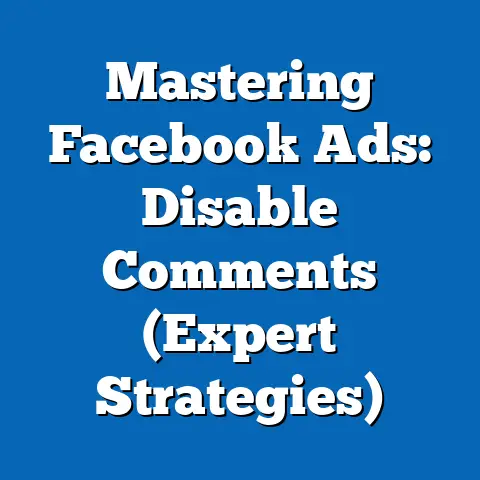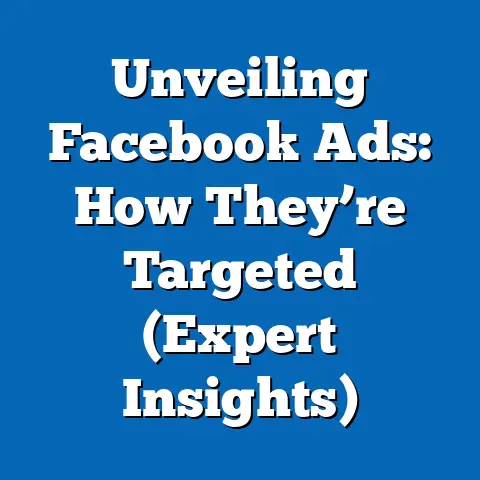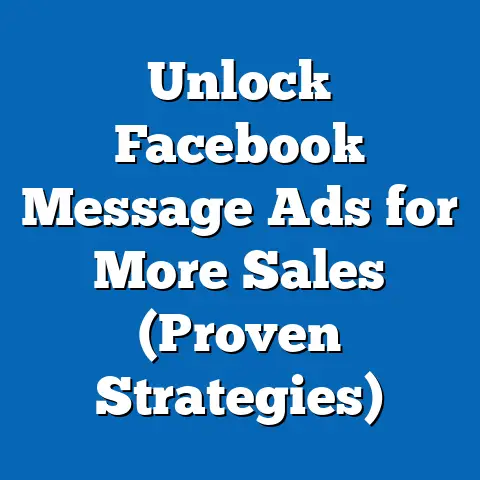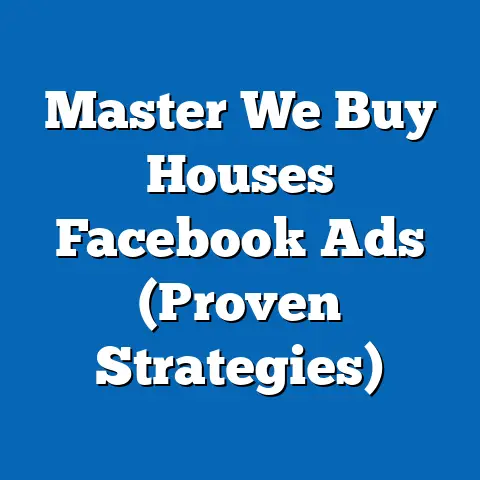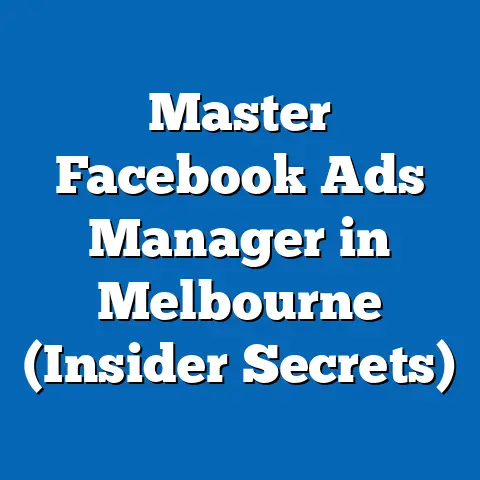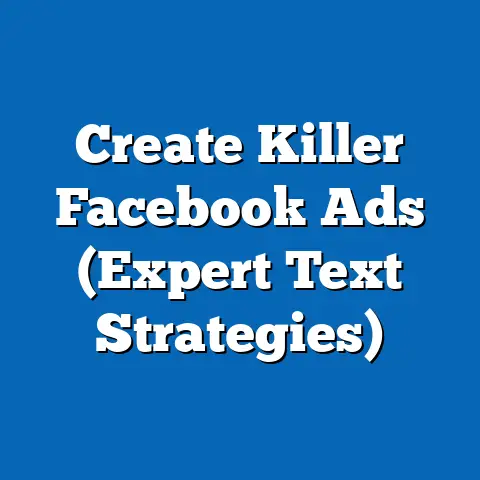Boost Facebook Ads: 15 Conversion Hacks (Pro Strategies)
Facebook advertising. Just the thought can bring a mix of excitement and, let’s be honest, a little bit of dread. We all know Facebook, now Meta, is a giant. With billions of active users, it’s a goldmine for businesses looking to connect with their target audience. But here’s the thing: simply running ads isn’t enough. You need to be strategic, creative, and constantly optimizing to truly see a return on your investment.
I’ve been working with Facebook Ads for over a decade now, and I’ve seen it all – the good, the bad, and the downright ugly. I’ve launched campaigns that skyrocketed conversions and others that… well, let’s just say they taught me some valuable (and sometimes expensive) lessons. One thing I’ve learned is that success on Facebook boils down to understanding the platform, your audience, and the ever-evolving trends that shape consumer behavior.
Right now, Facebook boasts over 2.9 billion monthly active users. That’s a massive audience, but it also means a lot of competition for attention. To stand out, you need to go beyond the basics and implement strategies that truly resonate with your target demographic. And that’s where conversion hacks come in.
Think of conversion hacks as those secret weapons that can significantly boost your ad performance. They’re not magic bullets, but they are proven tactics that, when implemented correctly, can lead to higher click-through rates, increased engagement, and ultimately, more conversions.
Understanding Seasonal Trends
One of the biggest mistakes I see businesses make with their Facebook ads is ignoring seasonal trends. It’s like trying to sell ice cream in the Arctic – you might get a few brave souls, but you’re missing out on a huge opportunity.
So, what exactly are seasonal trends? Simply put, they’re patterns in consumer behavior that fluctuate predictably throughout the year, often tied to specific events, holidays, or changes in the weather. Think of the surge in travel bookings around the holidays, the back-to-school shopping frenzy in late summer, or the increased demand for fitness products in January.
Why are these trends so important? Because they directly influence what people are searching for, what they’re interested in, and what they’re willing to buy. By aligning your ad campaigns with these seasonal events, you can tap into existing consumer demand and significantly improve your ad performance.
I remember working with a local florist shop a few years ago. They were running general ads year-round, but their sales were consistently low. When we started focusing on seasonal events like Valentine’s Day, Mother’s Day, and Christmas, their sales exploded. We created targeted ads featuring specific flower arrangements for each occasion, and the results were incredible.
Examples of Brands Utilizing Seasonal Trends
- Coca-Cola: Their Christmas campaigns are legendary, often featuring imagery of Santa Claus and promoting feelings of warmth and togetherness.
- Starbucks: The PSL (Pumpkin Spice Latte) is practically synonymous with autumn. Starbucks expertly leverages this seasonal favorite with targeted ads and promotions.
- Amazon: Prime Day is a massive, self-created seasonal event that drives billions of dollars in sales. Amazon uses Facebook Ads to promote Prime Day deals and attract new Prime members.
Researching and Identifying Relevant Trends
The key to leveraging seasonal trends is to do your research. Don’t just assume you know what your audience wants. Here’s how I approach it:
- Use Google Trends: This free tool allows you to track the popularity of search terms over time. You can see which keywords are trending and when they peak.
- Analyze Your Own Data: Look at your past sales data to identify patterns. Which products or services sell best during specific times of the year?
- Monitor Social Media: Pay attention to what people are talking about on social media. What hashtags are trending? What topics are generating the most engagement?
- Use Industry Reports: Many industry publications release reports on seasonal trends and consumer behavior. These reports can provide valuable insights into upcoming opportunities.
Tools and Resources
- Google Trends: (trends.google.com)
- Think with Google: (thinkwithgoogle.com) – Offers insights and data on consumer trends.
- Facebook Audience Insights: (within Facebook Ads Manager) – Helps you understand your audience’s interests and behaviors.
Takeaway: Understanding and leveraging seasonal trends is crucial for maximizing your Facebook Ads performance. By aligning your campaigns with consumer demand, you can increase engagement, drive conversions, and ultimately, grow your business. Start researching relevant trends today and plan your campaigns accordingly.
Conversion Hack #1 – Create Urgency with Time-sensitive Offers
One of the oldest tricks in the book, but still incredibly effective: creating a sense of urgency. People are naturally inclined to act when they feel like they might miss out on something. This is the core principle behind time-sensitive offers.
The idea is simple: offer a limited-time discount, promotion, or special deal to incentivize immediate action. Think “Sale ends tonight!” or “Limited stock available!” The key is to make the offer compelling and the deadline clear.
Tips for Crafting Compelling Time-Sensitive Offers
- Make the offer significant: A 5% discount might not be enough to create a sense of urgency. Aim for something more substantial, like 20% or more.
- Clearly state the deadline: Don’t be vague. Specify the exact date and time the offer expires.
- Use strong language: Words like “limited,” “exclusive,” and “final chance” can help create a sense of urgency.
- Create a countdown timer: Visually displaying the time remaining can be highly effective.
Examples of Effective Urgency-Based Ads
- An e-commerce store running a flash sale with a 24-hour deadline.
- A software company offering a free trial with a limited-time upgrade discount.
- A restaurant promoting a special menu item available only for a week.
Takeaway: Urgency is a powerful motivator. By creating time-sensitive offers, you can encourage immediate action and boost conversions. Just be sure to be transparent and avoid misleading your audience.
Conversion Hack #2 – Leverage User-Generated Content
In a world saturated with advertising, people are increasingly skeptical of brands. They trust recommendations from friends, family, and other consumers more than they trust traditional ads. That’s where user-generated content (UGC) comes in.
UGC is any content – photos, videos, reviews, testimonials – created by your customers and shared online. It’s authentic, relatable, and incredibly powerful. By featuring UGC in your Facebook Ads, you can build trust, enhance credibility, and drive conversions.
Strategies for Encouraging UGC
- Run a contest or giveaway: Encourage customers to submit photos or videos of themselves using your product.
- Ask for reviews and testimonials: Make it easy for customers to leave reviews on your website or social media pages.
- Create a branded hashtag: Encourage customers to use your hashtag when sharing their experiences.
- Reach out to satisfied customers: Ask if they’d be willing to share their story or provide a testimonial.
Examples of Brands Using UGC Effectively
- GoPro: Their entire marketing strategy is built around user-generated content. They feature stunning photos and videos captured by GoPro users around the world.
- Airbnb: They often showcase photos of unique Airbnb properties taken by guests.
- ASOS: They encourage customers to share photos of themselves wearing ASOS clothing using the hashtag #AsSeenOnMe.
Takeaway: UGC is a valuable asset that can significantly enhance your Facebook Ads. By leveraging the power of social proof, you can build trust, increase engagement, and drive conversions.
Conversion Hack #3 – A/B Testing Your Ad Creatives
Guesswork has no place in successful Facebook advertising. You can’t just assume that one ad creative will perform better than another. You need to test, test, and test again. That’s where A/B testing comes in.
A/B testing, also known as split testing, is the process of comparing two versions of an ad to see which one performs better. You can test different headlines, visuals, CTAs, targeting options – just about anything.
Setting Up A/B Tests
- Identify a variable to test: What do you want to improve? Click-through rate? Conversion rate?
- Create two versions of your ad: Change only one element at a time. For example, test two different headlines while keeping everything else the same.
- Set up your A/B test in Facebook Ads Manager: Facebook provides built-in tools for A/B testing.
- Run your test for a sufficient amount of time: Allow enough time for the test to gather statistically significant data.
- Analyze the results: Which version performed better? Use this information to optimize your ads.
Interpreting Results
Don’t just look at the surface-level numbers. Pay attention to statistical significance. A small difference in performance might not be meaningful. You want to see a clear and consistent winner.
Takeaway: A/B testing is essential for optimizing your Facebook Ads. By systematically testing different elements, you can identify what works best and continuously improve your ad performance.
Conversion Hack #4 – Use Video Ads to Capture Attention
In today’s fast-paced digital world, attention spans are shorter than ever. You have just a few seconds to grab someone’s attention and convince them to watch your ad. That’s why video ads are so effective.
Video is a highly engaging format that can quickly convey information and emotions. It’s also incredibly versatile. You can use video ads to tell a story, demonstrate a product, share a testimonial, or simply entertain your audience.
Tips for Creating Engaging Video Ads
- Grab attention in the first few seconds: Start with a compelling visual or a thought-provoking question.
- Keep it short and sweet: Aim for videos that are 15-30 seconds long.
- Use visuals that pop: Make sure your video is visually appealing and easy to watch on mobile devices.
- Include a clear call to action: Tell viewers what you want them to do.
Statistics on Video Ad Performance
- Video ads are 5x more likely to generate engagement than static ads.
- 84% of consumers have been convinced to buy a product or service by watching a video.
- Mobile video consumption is growing rapidly.
Takeaway: Video ads are a powerful tool for capturing attention and driving engagement on Facebook. By creating compelling videos that resonate with your target audience, you can significantly boost your ad performance.
Conversion Hack #5 – Optimize for Mobile Users
Let’s face it: most people access Facebook on their mobile devices. If your ads aren’t optimized for mobile, you’re missing out on a huge opportunity.
Mobile optimization goes beyond just making your ads look good on a small screen. It also involves creating a seamless and user-friendly experience for mobile users.
Strategies for Mobile Optimization
- Use mobile-friendly ad formats: Facebook offers several ad formats specifically designed for mobile devices, such as Instant Experiences and Collection Ads.
- Optimize your landing pages for mobile: Make sure your landing pages are responsive and load quickly on mobile devices.
- Use clear and concise copy: Mobile users have limited attention spans. Get straight to the point.
- Use large, easy-to-tap buttons: Make it easy for mobile users to click on your call to action.
Impact of Mobile User Experience on Conversion Rates
A poor mobile user experience can lead to high bounce rates and low conversion rates. By optimizing for mobile, you can improve user engagement and drive more sales.
Takeaway: Mobile optimization is crucial for success with Facebook Ads. By creating a seamless and user-friendly experience for mobile users, you can improve engagement and drive more conversions.
Conversion Hack #6 – Utilize Retargeting Strategies
Not everyone who sees your ad will convert immediately. In fact, most people need to see your message multiple times before they’re ready to take action. That’s where retargeting comes in.
Retargeting allows you to show ads to people who have previously interacted with your business, such as visiting your website, watching your video, or engaging with your Facebook page.
Examples of Effective Retargeting Campaigns
- Showing ads to people who abandoned their shopping cart on your website.
- Showing ads to people who watched a certain percentage of your video.
- Showing ads to people who visited specific pages on your website.
Segmenting Audiences for Better Retargeting
Don’t just show the same ad to everyone. Segment your audience based on their behavior and tailor your messaging accordingly. For example, show a different ad to people who abandoned their shopping cart than you show to people who simply visited your website.
Takeaway: Retargeting is a powerful tool for reaching people who are already familiar with your business. By segmenting your audience and tailoring your messaging, you can significantly boost your conversion rates.
Conversion Hack #7 – Craft Compelling Ad Copy
Let’s be real: your ad copy can make or break your campaign. It’s the first thing people read, and it’s what ultimately convinces them to click on your ad.
Compelling ad copy is clear, concise, and persuasive. It speaks directly to your target audience, addresses their needs and desires, and provides a clear call to action.
Tips for Writing Persuasive Ad Copy
- Know your audience: Who are you trying to reach? What are their pain points? What motivates them?
- Highlight the benefits, not just the features: Focus on how your product or service will improve their lives.
- Use strong verbs and action words: Create a sense of urgency and excitement.
- Keep it short and sweet: People don’t have time to read long paragraphs. Get straight to the point.
- Include a clear call to action: Tell people what you want them to do.
Examples of High-Converting Ad Copy
- “Tired of struggling with [problem]? Our [product/service] can help you [benefit] in just [timeframe].”
- “Get [desired result] with our proven [product/service]. Try it risk-free today!”
- “Limited-time offer: Get [discount] on our [product/service] before it’s too late!”
Takeaway: Crafting compelling ad copy is essential for driving clicks and conversions. By understanding your audience, highlighting the benefits, and using strong language, you can create ads that truly resonate.
Conversion Hack #8 – Harness the Power of Facebook Groups
Facebook Groups are a goldmine for reaching highly engaged and targeted audiences. They’re communities of people who share a common interest, passion, or goal. By leveraging Facebook Groups, you can connect with potential customers, build relationships, and drive conversions.
Engaging with Group Members
Don’t just spam the group with your ads. Instead, focus on providing value and building relationships. Answer questions, share helpful tips, and participate in discussions.
Promoting Products/Services Organically
Once you’ve established yourself as a valuable member of the community, you can start promoting your products or services organically. Share relevant content, offer exclusive discounts, and invite people to learn more about your business.
Case Studies of Brands Using Facebook Groups
- Many fitness brands have created Facebook Groups for their customers to share their progress, ask questions, and support each other.
- Several cooking brands have created Facebook Groups for people to share recipes, tips, and tricks.
- Numerous parenting brands have created Facebook Groups for parents to connect, share advice, and ask questions.
Takeaway: Facebook Groups are a powerful tool for reaching targeted audiences and driving conversions. By engaging with group members, providing value, and promoting your products/services organically, you can build a loyal customer base.
Conversion Hack #9 – Collaborate with Influencers
Influencer marketing is a hot topic, and for good reason. It’s a highly effective way to reach new audiences, build trust, and drive conversions.
Influencers are people who have a large and engaged following on social media. They have the ability to influence their followers’ purchasing decisions. By collaborating with relevant influencers, you can tap into their audience and promote your products or services.
Identifying and Collaborating with Influencers
- Identify influencers in your niche: Look for people who have a large and engaged following that aligns with your target audience.
- Reach out and build a relationship: Don’t just send a generic email. Take the time to research the influencer and personalize your message.
- Offer something of value: Offer them a free product, a discount code, or a paid sponsorship.
- Clearly define your expectations: What do you want them to do? How often do you want them to post?
Success Stories of Campaigns Integrating Influencer Partnerships
- Fashion brands often collaborate with fashion bloggers to showcase their clothing.
- Beauty brands often collaborate with beauty vloggers to review their makeup.
- Food brands often collaborate with food bloggers to create recipes using their products.
Takeaway: Influencer marketing can be a highly effective way to reach new audiences and drive conversions. By collaborating with relevant influencers, you can tap into their audience and promote your products or services.
Conversion Hack #10 – Use Lookalike Audiences for Targeting
Facebook’s Lookalike Audiences are a game-changer for targeting. They allow you to reach people who are similar to your existing customers, significantly increasing your chances of finding new customers who are likely to convert.
How Lookalike Audiences Work
You start by providing Facebook with a source audience, such as your email list, website visitors, or existing customers. Facebook then analyzes the characteristics of this audience and finds other people on Facebook who share similar traits.
Creating Lookalike Audiences
- Go to Facebook Ads Manager: Navigate to the “Audiences” section.
- Create a new audience: Select “Lookalike Audience.”
- Choose your source audience: Select the audience you want to use as the basis for your lookalike audience.
- Select your desired audience size: The smaller the audience size, the more similar the lookalike audience will be to your source audience.
- Create your audience: Facebook will create your lookalike audience.
Potential Impact on Conversion Rates
Lookalike Audiences can significantly improve your conversion rates by targeting people who are more likely to be interested in your products or services.
Takeaway: Lookalike Audiences are a powerful tool for expanding your reach and driving conversions. By targeting people who are similar to your existing customers, you can significantly increase your chances of finding new customers who are likely to convert.
Conversion Hack #11 – Implement Dynamic Ads
Dynamic Ads are a must-have for e-commerce businesses. They allow you to automatically show ads to people who have viewed specific products on your website, reminding them of what they were interested in and encouraging them to make a purchase.
Benefits of Dynamic Ads
- Highly targeted: Dynamic Ads are shown to people who have already expressed interest in your products.
- Personalized: Dynamic Ads show the exact products that the person viewed on your website.
- Automated: Dynamic Ads are automatically created and updated based on your product catalog.
Setting Up Dynamic Ads
- Create a product catalog: Upload your product information to Facebook.
- Install the Facebook pixel: Track website visitors and their behavior.
- Create a dynamic ad campaign: Select the “Catalog Sales” objective.
- Target your audience: Choose to retarget people who have viewed specific products on your website.
- Create your ad template: Design the ad that will be shown to potential customers.
Examples of Brands Using Dynamic Ads
- Fashion retailers use Dynamic Ads to show people the clothes they viewed on their website.
- Travel companies use Dynamic Ads to show people the hotels they viewed on their website.
- Electronics retailers use Dynamic Ads to show people the electronics they viewed on their website.
Takeaway: Dynamic Ads are a powerful tool for e-commerce businesses. By automatically showing ads to people who have viewed specific products on your website, you can significantly boost your sales.
Conversion Hack #12 – Monitor Ad Performance Metrics
You can’t improve what you don’t measure. That’s why it’s crucial to monitor your ad performance metrics regularly. By tracking key metrics, you can identify what’s working and what’s not, and make informed adjustments to your ad campaigns.
Key Performance Metrics to Track
- Click-Through Rate (CTR): The percentage of people who click on your ad after seeing it.
- Conversion Rate: The percentage of people who take the desired action after clicking on your ad.
- Cost Per Click (CPC): The amount you pay each time someone clicks on your ad.
- Cost Per Conversion (CPC): The amount you pay for each conversion.
- Return on Ad Spend (ROAS): The amount of revenue you generate for every dollar you spend on advertising.
Analyzing Data
Don’t just look at the numbers. Try to understand why your ads are performing the way they are. Are your headlines not compelling enough? Is your targeting too broad? Is your landing page not optimized for conversions?
Using Facebook Analytics
Facebook Analytics provides deeper insights into your audience’s behavior and how they interact with your website and app. Use this data to further optimize your ad campaigns.
Takeaway: Monitoring your ad performance metrics is essential for optimizing your Facebook Ads. By tracking key metrics, analyzing data, and using Facebook Analytics, you can make informed adjustments to your campaigns and improve your results.
Conversion Hack #13 – Optimize Landing Pages for Conversions
Your Facebook ad is just the first step. Once someone clicks on your ad, they’re taken to your landing page. If your landing page isn’t optimized for conversions, you’re likely losing out on sales.
Improving Landing Page Design and Content
- Make sure your landing page aligns with your ad messaging: The message on your landing page should be consistent with the message in your ad.
- Use a clear and concise headline: Tell people what you want them to do.
- Highlight the benefits, not just the features: Focus on how your product or service will improve their lives.
- Use strong visuals: Include images or videos that showcase your product or service.
- Include a clear call to action: Tell people what you want them to do.
- Make it easy to convert: Remove any unnecessary distractions and make it easy for people to fill out a form, make a purchase, or take whatever action you want them to take.
Examples of Effective Landing Pages
- Landing pages that use clear and concise headlines.
- Landing pages that highlight the benefits of the product or service.
- Landing pages that use strong visuals.
- Landing pages that include a clear call to action.
- Landing pages that make it easy to convert.
Takeaway: Optimizing your landing pages is crucial for maximizing your conversion rates. By aligning your landing page with your ad messaging, using clear and concise language, and making it easy to convert, you can turn more clicks into customers.
Conversion Hack #14 – Incorporate Seasonal Themes into Ads
We touched on seasonal trends earlier, but this hack goes a step further. It’s about actively incorporating seasonal themes into your ad visuals and messaging.
Think of it this way: during the holidays, people are naturally drawn to festive imagery and messaging. By incorporating these elements into your ads, you can capture their attention and make your ads more relevant.
Examples of Brands Aligning Ads with Seasonal Themes
- During the holidays, many brands use imagery of Christmas trees, snow, and Santa Claus in their ads.
- During the summer, many brands use imagery of beaches, sunshine, and outdoor activities in their ads.
- During back-to-school season, many brands use imagery of school supplies, backpacks, and students in their ads.
Maintaining Brand Consistency
While it’s important to embrace seasonal elements, it’s also important to maintain brand consistency. Make sure your ads still reflect your brand’s personality and values.
Takeaway: Incorporating seasonal themes into your ads can be a highly effective way to capture attention and make your ads more relevant. Just be sure to maintain brand consistency.
Conversion Hack #15 – Engage with Comments and Messages
Your Facebook ad campaign shouldn’t be a one-way street. It’s an opportunity to engage with potential customers, answer their questions, and build relationships.
Responding to Comments and Messages
Respond to comments and messages promptly and professionally. Show people that you care about their questions and concerns.
Improving Conversions Through Active Engagement
By actively engaging with potential customers, you can build trust, answer their questions, and ultimately, increase your chances of converting them into customers.
Takeaway: Engagement is key to building relationships and driving conversions. By responding to comments and messages promptly and professionally, you can show people that you care about their questions and concerns.
Conclusion
So, there you have it – 15 actionable conversion hacks that you can implement today to boost your Facebook Ads results. I know it seems like a lot to take in, but trust me, it’s worth the effort.
Remember, Facebook advertising is an ongoing process. It’s not something you can set and forget. You need to continuously test, optimize, and adapt to stay ahead of the competition.
I encourage you to start implementing these strategies and track your results. Share your successes (and your challenges!) with the community. We’re all in this together, and we can learn from each other.
The digital landscape is constantly evolving, and Facebook is no exception. New features, algorithms, and best practices are emerging all the time. By staying informed, experimenting with new strategies, and continuously optimizing your campaigns, you can ensure that your Facebook Ads are always performing at their best. Good luck, and happy advertising!

